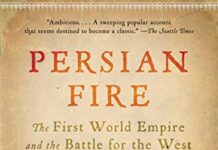
Ebook Info
- Published: 2007
- Number of pages: 465 pages
- Format: PDF
- File Size: 4.68 MB
- Authors: Tom Holland
Description
A vivid historical account of the social world of Rome as it moved from republic to empire. In 49 B.C., the seven hundred fifth year since the founding of Rome, Julius Caesar crossed a small border river called the Rubicon and plunged Rome into cataclysmic civil war. Tom Holland’s enthralling account tells the story of Caesar’s generation, witness to the twilight of the Republic and its bloody transformation into an empire. From Cicero, Spartacus, and Brutus, to Cleopatra, Virgil, and Augustus, here are some of the most legendary figures in history brought thrillingly to life. Combining verve and freshness with scrupulous scholarship, Rubicon is not only an engrossing history of this pivotal era but a uniquely resonant portrait of a great civilization in all its extremes of self-sacrifice and rivalry, decadence and catastrophe, intrigue, war, and world-shaking ambition.
User’s Reviews
Reviews from Amazon users which were colected at the time this book was published on the website:
⭐A lot of material but produced very well. I have enjoyed Tom Holland’s books. That last chapter on the end of the Republic and the rise of Augustus is very relatable
⭐This is an absolutely wonderful panorama on one the the great historical watersheds: the slide to the end of the Roman Republic. In luminous prose, Holland begins with the rivalry of Marius and Sulla. These two generals appeared in the period when Rome was expanding so rapidly that a new source of manpower had to be found: rather than exclusively rely on landowners, Marius began to enlist anyone who would serve. The new recruits had nowhere to return to, hence their loyalties belonged more to their leader (i.e. the military) than to any idea of “the republic” (i.e. the republican “citizens” who were land-owning yeoman farmers, a mythic ideal). The consequences were extremely grave: when Sulla ordered them to attack Rome after he was politically out-maneuvered, they obeyed, beginning a period of catastrophic instability at the moment that ROme was facing new pressures from several directions. Law no longer ruled, military power and personal loyalty did.Holland also explains, in a clearer way than I have ever read, how the republic was a combination of centuries-old custom, of essentially religious reverence. Citizens respected the institutions, which had proven resilient and adaptable for nearly 500 years, ever expanding representation and reasonably just, at least for its citizens. While not a democracy as we understand it, neither was it a monarchy or pure aristocracy. Tradition and law dictated that soldiers would never enter the city in a military capacity; all accused citizens could seek justice in the courts; careers were not exclusively dependent on birth right. Officials changed office every year, by vote, and the Senate was a permanent body of respected elders in addition to knaves. Finally, there was a rough consensus of the value of seeking glory and the respect of one’s peers, more or less in the service of republican ideals. There were, of course, plenty of contradictions and corrupt practices, in addition to slaves and the disenfranchisement of women. Holland offers a wonderfully detailed, yet never pedantic, explanation of the republic’s functioning.At the moment of Marius and Sulla, the institutions were proving less and less able to cope with the challenges of what was becoming a vaste empire: consuls (top executives elected to serve one year) often had to travel for more than one year to deal with military threats, the constant change-over of personnel made the implementation of consistent policies impossible (a good governor could only do so much before being replaced by a corrupt one), etc. Holland’s portrait is so varied and complex that it cannot be summarized here. There are many wonderful mini-biographies as the narrative progresses; I would compare it to The Best and the Brightest by Halberstam.By the time Caesar and Pompey arrived on the scene, the institutions of the republic were in precipitous decline; it was a combination of personal ambitions and structural weaknesses. Sulla and Marius, in their civil war, had decimated the senate, “proscribing” (killing by bounty) many of its most respected and competent members (enemies but also to plunder the rich); those who remained, like Cato, were rigid and lacking in pragmatism, unable to negotiate compromise for the greater good. Even Cicero, in my reading, was a mediocre politician, in spite of his genius as an orator and rhetorician. Moreover, with an empire in formation, its institutions required radical revision to survive – greater continuity of tenure and less politicized military careers. Once a new political crisis emerged – between Caesar and Pompey, rivals for glory – the pressure to return to an autocracy was perhaps too great. Caesar destroyed the republic out of wounded pride and a sense of entitlement to glory. It was then left to Octavian to create a new system as Rome entered its Imperial period.As an autocracy, in my reading, this development closed many possible evolutionary paths, dooming the antique world to a place of competing despots and empires. The example for today, the parallels and differences, remain relevant and fascinating. Holland does not get into this kind of reasoning and does not describe how Roman mores changed for the Empire. I hope he will write a sequel to this book that does cover these issues.This is an absolutely first-rate popular history. I was rivetted from page 1 and could not put it down. It reads fast and never gets bogged down in academic trivia. Recommended with the greatest enthusiasm.
⭐I’ve previously learned the history of the fall of the Republic, but Holland provides a brilliant account of Rome based on surviving contemporary artefacts. He breathes life into the players, setting, conflicts, and human elements. A must read for any fan of history, Rome, or flowery language.
⭐The best narrative history that I have ever read. So good that I could not stop reading. A must read.
⭐I’ve long had a fascination with the characters and politics of ancient Rome, whether it be the Republican Period or the Imperial Period that followed the fall of the Republic. However, the most fascinating time for me, perhaps because of the vivid and larger-than-life characters in the cast, the gruesome violence of its politics, and the sheer scale of the stage (from the tip of Spain west to the far shores of the Black Sea east, from the shores of Britain north to the deserts of Africa and the Nile south), is the period as the Republic began to falter and fail and the Roman Empire began to ascend.Perhaps this period has gained even more currency with me recently because so much of our own politics in many ways echoes the arguments and politics of the Roman Republic. As I have listened, and occasionally participated in, debates and discussions about the role of government, I have heard arguments not unlike those that once were made in the Forum by senators of Rome. How much power should government have, what government should, and shouldn’t, do for the people, whether we should engage in wars far across the ocean, whether we should be nation building, what should we do with the many millions of people immigrating across our borders, who should be an American, and so on, and so on. Long before the modern American Republic encountered these issues, the Roman people–under the Republic–debated these issues from in the Forum of Rome.With these thoughts in mind, as well as a love for gritty and real bare knuckle politics of ancient Rome, I picked up Tom Holland’s book. Told in a narrative style with vibrant language, the story reads with novel like ease and speed. But for footnotes and awareness of the history being accounted from other sources, I might have wondered at the fictional like quality to it.All the great names of Roman history are present. Julius Caesar and his legions. Marcus Cicero, the oratorical giant. Pompey the Great, hero and megalomaniac. Cleopatra, seducer, queen and Pharaoh-goddess. And, of course, my favorite, Cato, the Spartan like idealist and champion of Republican principles, falling upon his sword rather than surrender to dictatorship as Caesar’s army marches on Utica.I usually confine my gym reading to “fun stuff,” like novels and other brain candy. However, I found that Holland’s history was sufficiently enjoyable that I had difficulty picking up other books for the duration of the read, including at the gym. For those who complain that history is boring, a list of “one thing after another,” Holland’s Rubicon may be for them. For in it, they may find that `yes,’ history does seem to repeat itself, but no, it is not just one thing after another, nor is it boring. Roman history, especially in Holland’s telling, is as vibrant, alive, and violent as the Italian operas that their descendants would write over fifteen hundred years later.Rubicon is, ultimately, a tragic tale marked by violence, civil war, conquest and the fall of the world’s longest standing republic. As the turmoil begins to end, we see Octavian rise as the second Caesar, but really as the first emperor, of Rome. His long life and mostly peaceful reign were a marked difference from the tumultuous years of the Republics fall, and they gave rise to a different period in Rome’s, and the West’s, history. It would be more than seventeen hundred years before another republic with Rome’s staying power was established.As the only constant in history is change, as I closed the book, I could not help but wonder how long our republic will last. I don’t mean to speak doom and gloom by saying so, only to point out that human nature is tends to bring about repetition of history, including the failures of democracies and republics alike. How long can ours last? Even if it is only at mid-point or, to be optimistic, a relative beginning, what duration can it have? And will the causes of Rome’s fall also cause ours to fall?
⭐The title refers to the decisive moment in Roman history when Julius Caesar crossed the Rubicon and the fate of the Roman Republic was sealed. The phrase crossing the Rubicon is now part of our everyday language meaning passing a point of no return. That is an apt analogy for this book because it is hard to put down!As well as being a classically trained scholar, Tom Holland is also an accomplished novelist and this explains why this book is so compelling. He weaves a narrative that reflects his award winning history writing ability with that of a storyteller. He combines the research skills and erudition of a specialist with the dramatic prose of a fine writer to create a dramatic and compelling narrative. In this regard he is perhaps more akin to Antony Beevor than Mary Beard.I would recommend this book as an entry point for everyone. If you wish to probe further, Holland’s extensive bibliography will help you find what you need. It is detailed and useful. He is adept at bringing characters to life which have been studied and wrote about for over 2000 years whether by Herodotus or Shakespeare, or in big screen epics or TV series. These people matter to us and this books brings a fresh lease of life to them. If you enjoy the USA TV show House of Cards then this book is for you as there are numerous similarities – only the names seem to change as plots and conspiracies abound, loyalties change at a moment’s notice while the quest for power plays out.There are plenty of colour and black and white illustrations and the maps are clear if lacking a little detail. Holland keeps us interested from start to finish and is the type of author you then want to read everything else they’ve written.A great read and would make a good gift.
⭐A superb history of the Roman Republic, full of passion and life.Unlike general histories, which will try to describe and explain every little detail, Tom Holland succinctly brings together a grand narrative that weaves together the most important characters and events into a rich tapestry.While at times he is dependent on the original writings from Rome, which are perhaps more fiction than fact, at least it means the overall story is sourced from what the Romans wrote about themselves. Even better is that Holland manages to make many of the leading figures feel real using only the slightest strokes.Overall, a wonderful achievement, and the best general history of the Roman Republic I’ve read to date.
⭐An excellent overview of Rome before the advent of the emperors. All the main battles, personalities, considerations are featured as well as a spotlight shone on the last days of the old republic. The truth was that the system worked for generations but eventually became riddled with corruption, internal struggles, and too many competing factions. The last 50 years of the republic saw 2 dictatorships and 2 triumvarates which seemingly made the autocracy of the emperors inevitable. The book is very well written and informative.
⭐I especially like Tom’s way of writing where he amalgamates academic style with certain witticisms that make the reading of his novels more enjoyable and at times quite amusing. I like how he taps into rather tabu subjects which are sometimes disregarded by other historians, such as his sections on the orgies and wild parties in the Bay of Naples or the extravagances of the super-rich in the late republican period.
⭐I bought this book after reading Robert Harris’ trilogy of novels (Imperium, Lustrum, Dictator) which covers the same period but from the perspective of Cicero. I found the novels hard to put down and was pleasantly surprised to find that Holland’s factual, historical account was equally gripping. But, unlike in the novels, Cicero does not come out of Holland’s work very favourably, appearing as a somewhat vacillitating and indecisive character.
Keywords
Free Download Rubicon: The Last Years of the Roman Republic in PDF format
Rubicon: The Last Years of the Roman Republic PDF Free Download
Download Rubicon: The Last Years of the Roman Republic 2007 PDF Free
Rubicon: The Last Years of the Roman Republic 2007 PDF Free Download
Download Rubicon: The Last Years of the Roman Republic PDF
Free Download Ebook Rubicon: The Last Years of the Roman Republic





